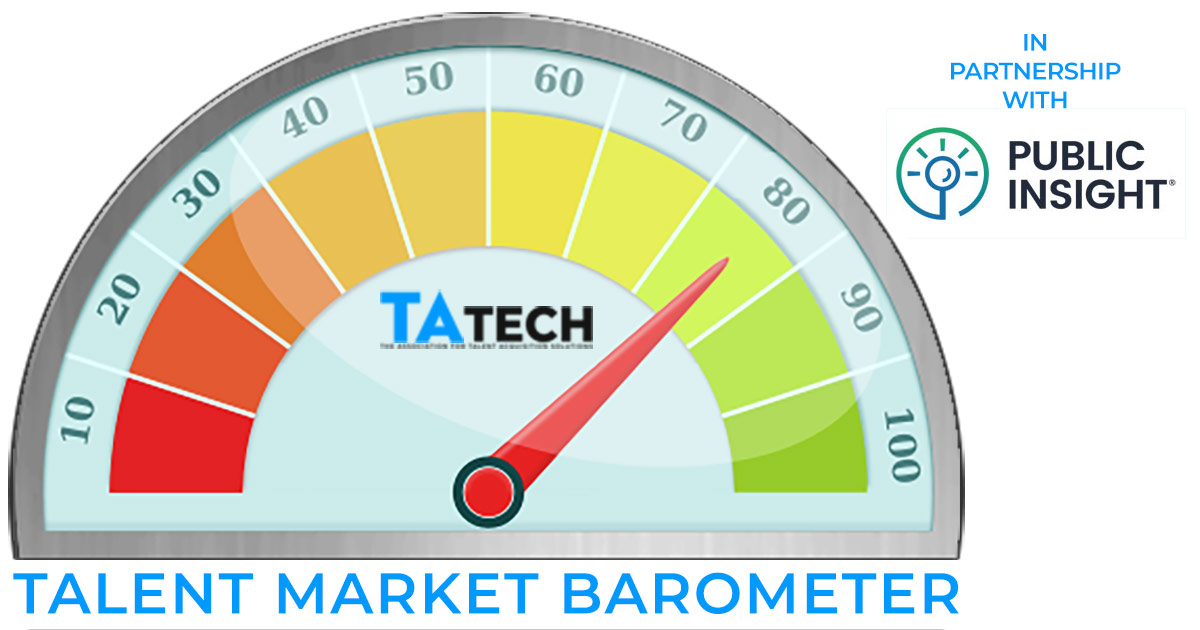By Peter Weddle, CEO of TAtech, and Dan Quigg, CEO of Public Insight®
The barometer has been a metaphor in business for decades. At one time or another, there’s been a consumer barometer, a stock market barometer, and even an employee mood barometer. The actual instrument may have been designed to predict the weather, but it has long been used to assess the direction of virtually every aspect of commercial activity … except one: The talent market. And now TAtech and Public Insight have teamed up to correct that deficiency.
What makes the barometer such a good metaphor for sussing out the business climate? According to National Geographic, the instrument measures air pressure, and that metric can forecast short-term changes in the state of the weather. When air pressure drops, lousy weather is on the way, whereas an increase in that pressure means you’ll have good weather for your day at the beach.
Similarly, business-related barometers typically use commercial metrics to signal near-term changes in the productivity, sales or earnings of a specific market or industry segment. Some are solidly grounded in quantitative data and are as reliable (or almost so) as weather-related barometers. Others use qualitative data that are susceptible to biases or misassumptions and thus have to be taken with more than a few grains of salt.
The TAtech Talent Market Barometer
The January TAtech Talent Barometer will be published shortly.
The Talent Market Barometer uses data to forecast the state of the talent acquisition marketplace on a monthly basis. Public Insight acquires the market data from Indeed and Glassdoor (Recruit Holdings) as well as select government publications and then analyzes it to produce a broad range of in-depth metrics. Why Indeed and Glassdoor? Because given their size and reach, they provide a targeted 70 percent market proxy and generate a significant trove of relevant, empirical data.
The TAtech Barometer takes two of Public Insight’s library of 150 metrics and examines them for each of a sample of six industry sector workforce cohorts:
• Retail
• Accommodation & Food Services
• Transportation & Warehousing
• Professional, Scientific & Technical Services
• Finance & Insurance
• Healthcare
The two metrics are:
Supply-Demand Ratio
Supply-Demand Ratio is a measurement of the supply of resumes vs. unique job postings (i.e., job postings net of repostings) in an industry. If the monthly ratio is greater than one, there are more job seekers with resumes in the market than there are posted jobs; conversely, if the ratio is less than one, there are more jobs being posted than there are job seekers with resumes in the market.
For example, during December 2022, the Supply-Demand Ratio for the Accommodation & Food Services sector was 1.30, meaning that there were significantly more job seekers in the market than jobs being posted. Conversely, the Supply-Demand Ratio for the Professional, Scientific & Technical Services sector was 0.63, meaning there were significantly more job postings than job seekers in the market.
In effect the Talent Market Barometer is saying that the state of the talent market in December was positive for recruiters in the Accommodation & Food Services sector, but negative in the Professional, Scientific & Technical Services sector.
Net Migration
Net Migration is a measurement of resumés coming into an industry over those exiting an industry. If the monthly number is positive, more people are coming into an industry than leaving it; conversely, if the number is negative, it means more are leaving an industry than coming into it.
For example, during December, 2022, Net Migration for Finance & Insurance was -9.8%, meaning that more people left than entered that industry sector, compared to the previous month. In contrast, Net Migration for the Transportation & Warehousing sector was +108.1%, meaning that significantly more people entered that industry than left it, compared to the previous month.
In effect the Talent Market Barometer is saying that the state of the talent market in December was negative for recruiters in Finance & Insurance, but positive for those in Transportation & Warehousing.
Overall
Among the basket of six representative industry sectors in December:
• Two sectors – Retail and Transportation & Warehousing – were positive and trending up (job seekers were entering the sectors)
• One sector – Accommodation & Food Services – was positive but trending down (job seekers were leaving the sector)
• Two sectors – Finance & Insurance and Healthcare – were negative and trending down.
• One sector – Professional, Scientific & Technical Services – was negative but trending up.
Therefore, the talent market for December 2022 is rated as mixed. Three sectors were up, three sectors were down, three were trending up and three were trending down. Conditions may vary in your specific target market. The Barometer's readings for January 2023 will be published shortly.
Job Market Data & Analytics: Public Insight provides job market insights that optimize recruiting and career strategies and improve talent acquisition.

